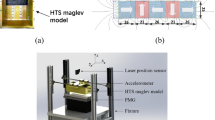Abstract
Based on the 3-D model, we recently proposed to investigate numerically the performance of the HTS maglev system. The speed-related behavior of this kind of maglev system is further studied in this article. The 3-D model is firstly briefly introduced: the 3-D governing equations are established with current vector potential (T) as the state variable, and the special anisotropic behavior and the nonlinear E–J characteristic of the HTS were taken into account by an elliptical model and power-law model, respectively. Using a translational symmetry levitation system, which is composed of a rectangular HTS and a permanent magnet guideway (PMG) as an example, the speed-related behavior of the magnetic force in three different cases—i.e., the levitation force (LF) versus gap relation under the vertical movement, the time evolution of the LF, the guidance force (GF) versus lateral displacement relation under the transverse movement—are investigated. The result indicates that, with the increase of the speed, both the LF and GF increase but the rate of increase is reduced and finally saturates when the speed is large enough. We also find that the commonly used speed of 1 mm/s to investigate the magnetic force of the bulk HTS in the experiment is reasonable because both the LF and GF tend to saturate at this speed. For the time evolution study of the LF, although the peak value of the LF is largest when the speed is largest, the LF decay in the relaxed process is most serious, and consequently the final LF at different speeds is almost identical after relaxation. Therefore, the magnetic force cannot be enhanced by simply increasing the speed in the practical application.
Similar content being viewed by others
References
Yoshida, Y., Uesaka, M., Miya, K.: Int. J. Appl. Electromagn. Mater. 5, 83 (1994)
Postrekhin, E., et al.: IEEE Trans. Appl. Supercond. 11, 1984 (2001)
Qin, M.J., et al.: Phys. Rev. B 66, 024516 (2002)
Kasal, R.B., et al.: IEEE Trans. Appl. Supercond. 17, 2158 (2007)
Wang, W., et al.: IEEE Trans. Appl. Supercond. 20, 2214 (2010)
Ma, G., Wang, J., Wang, S.: IEEE Trans. Appl. Supercond. 20, 2219 (2010)
Ma, G., Wang, J., Wang, S.: IEEE Trans. Appl. Supercond. 20, 2228 (2010)
Rhyner, J.: Physica C 22, 292 (1993)
Halbach, K.: J. Appl. Phys. 57, 3605 (1985)
Ma, G., Wang, J., Wang, S.: J. Supercond. Nov. Magn. 22, 841 (2009)
Author information
Authors and Affiliations
Corresponding author
Rights and permissions
About this article
Cite this article
Ma, GT., Wang, JS. & Wang, SY. Numerical Study of the Speed-Related Behavior of the Magnetic Force in the HTS Maglev System Based on a 3-D Model. J Supercond Nov Magn 24, 1593–1598 (2011). https://doi.org/10.1007/s10948-010-1062-8
Received:
Accepted:
Published:
Issue Date:
DOI: https://doi.org/10.1007/s10948-010-1062-8




